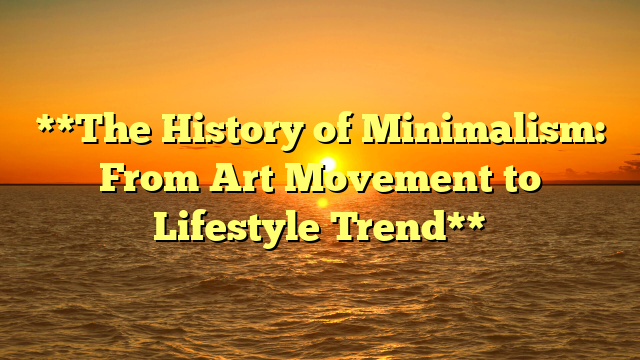
Minimalism has become a popular lifestyle choice in recent years, encouraging people to live with less and focus on what truly matters. However, minimalism is not a new concept. It has deep historical roots, originating as an art movement before evolving into a broader philosophy that influences design, architecture, fashion, and daily living. Understanding the history of minimalism provides insight into how it transitioned from a creative expression to a way of life embraced by millions.
**The Birth of Minimalism in Art (1950s–1960s)**
Minimalism first emerged as an art movement in the 1950s and 1960s in response to the complexity and emotional intensity of abstract expressionism. Artists sought to remove unnecessary elements and focus on pure form, color, and space. They believed that art should be simple, objective, and free from personal interpretation.
Key minimalist artists such as Donald Judd, Frank Stella, and Dan Flavin created works characterized by geometric shapes, repetition, and industrial materials. Unlike traditional art, which often told a story or conveyed emotion, minimalist art aimed to strip everything down to its essential elements, allowing viewers to experience the artwork without distraction.
**Minimalism in Architecture and Design (1970s–1980s)**
As the minimalist art movement gained recognition, its principles influenced architecture and interior design. Architects like Ludwig Mies van der Rohe and Tadao Ando embraced simplicity, clean lines, and open spaces, prioritizing function over decoration. Mies van der Rohe’s famous phrase, **“Less is more,”** became the defining motto of minimalist design.
Minimalist architecture is known for:
– Neutral color palettes
– Open floor plans
– Uncluttered spaces
– The use of natural light and simple materials
During the 1980s, minimalism extended to product design, influencing companies like Apple. The brand’s sleek, functional, and user-friendly products reflect minimalist principles, proving that simplicity can enhance both aesthetics and functionality.
**Minimalism as a Lifestyle (1990s–Present)**
In the late 20th and early 21st centuries, minimalism transitioned from an artistic and design movement into a lifestyle philosophy. The rise of consumer culture, fast fashion, and digital distractions led many to seek a simpler, more intentional way of living.
Influential figures such as Marie Kondo, Joshua Fields Millburn, and Ryan Nicodemus popularized the idea of decluttering and living with only what adds value. Books like *The Life-Changing Magic of Tidying Up* and *The Minimalists: Live a Meaningful Life* inspired people to let go of excess and focus on experiences over possessions.
Modern minimalism promotes:
– Decluttering and reducing material possessions
– Prioritizing quality over quantity
– Living in smaller, more efficient spaces
– Practicing mindful consumption and sustainability
Minimalism has also influenced digital lifestyles, leading to trends such as digital detoxing, capsule wardrobes, and simplified workspaces. From samosir88 in art to its widespread adoption as a lifestyle, minimalism has evolved into a philosophy that promotes simplicity, efficiency, and intentionality. Whether applied to art, architecture, design, or everyday life, minimalism continues to shape modern culture, helping people find clarity and peace in a world filled with excess.



